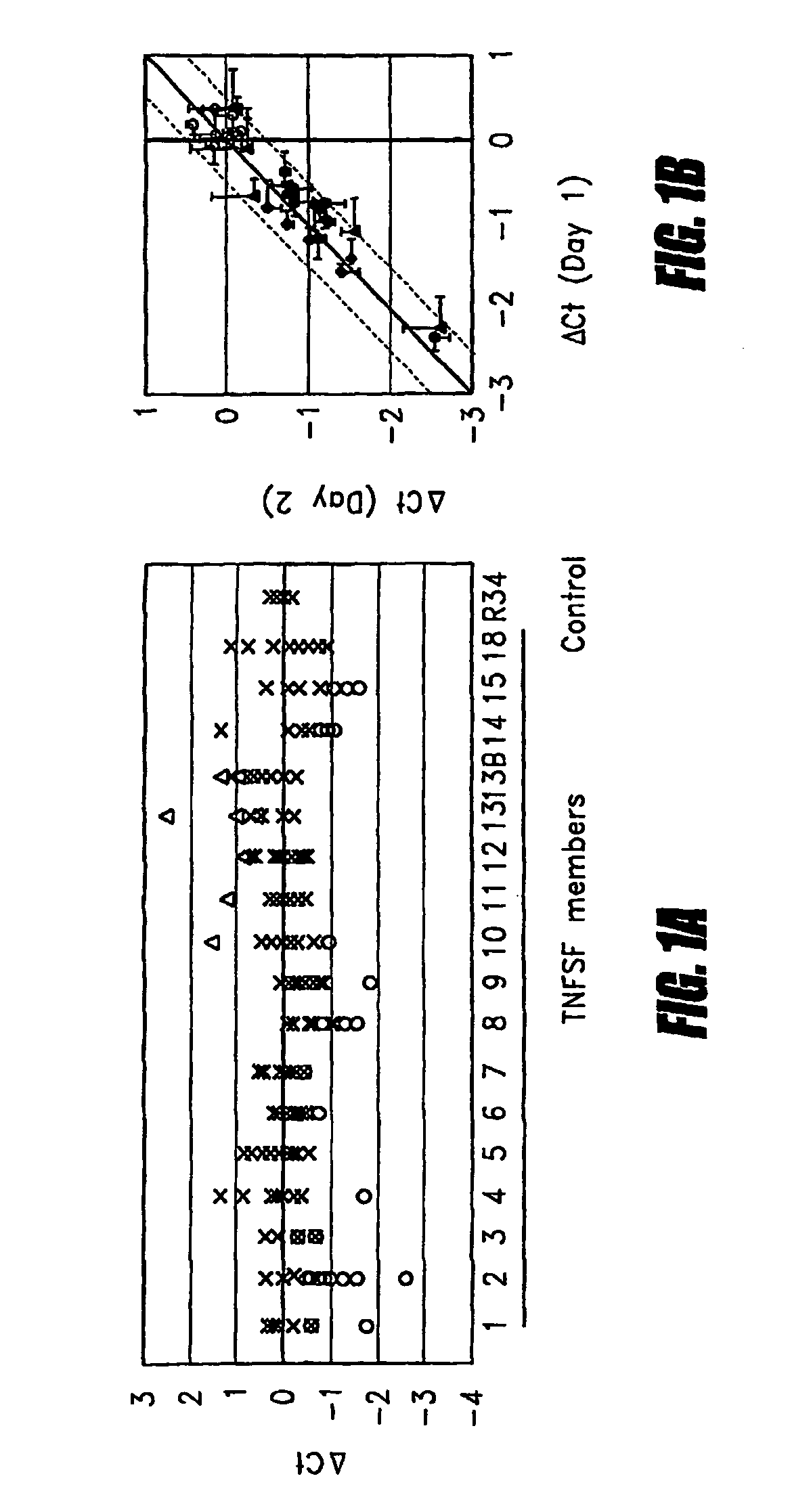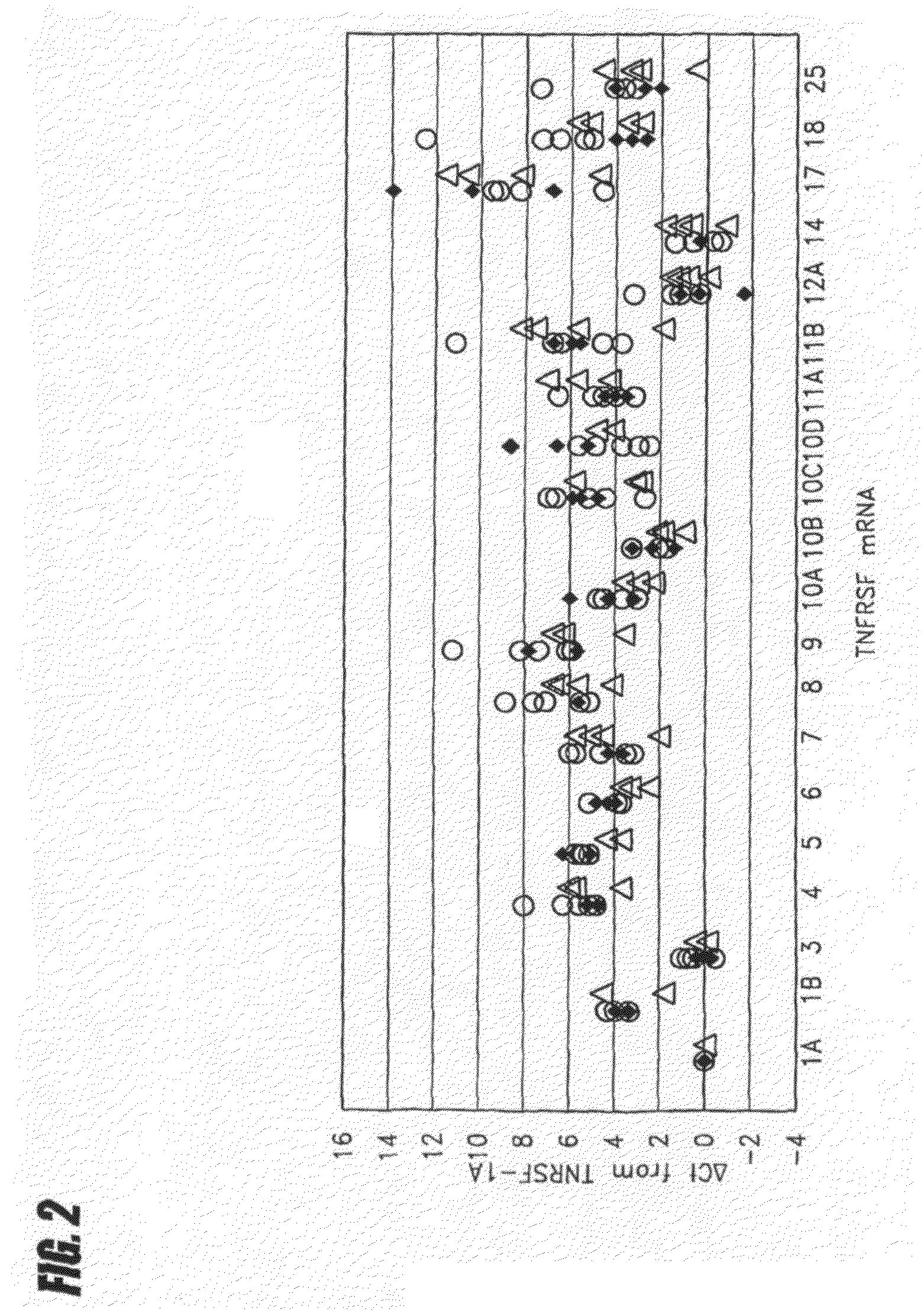Method for predicting immune response to neoplastic disease based on mRNA expression profile in neoplastic cells and stimulated leukocytes
a neoplastic cell and expression profile technology, applied in the field of predicting the immune response to neoplastic disease based on the expression profile of mrna in neoplastic cells and stimulating leukocytes, can solve the problem of difficult interpretation of the identification of the tnf superfamily subtype expressed in infiltrating mononuclear cells
- Summary
- Abstract
- Description
- Claims
- Application Information
AI Technical Summary
Benefits of technology
Problems solved by technology
Method used
Image
Examples
embodiment 1
[0039]The mRNA quantitation method described above was employed to quantitate all types of TNF superfamily mRNA, both with and without ex vivo stimulation using heat-aggregated IgG (HAG), which was employed as a model of immune complex stimulation (see Ostreiko et al., Production and characterization of heat-aggregated IgG complexes with pre-determined molecular masses: light-scattering study, Immunol Lett. 1987; 15:311-6). The immune complex is formed when IgG molecules bound to a target cell bind with high avidity to Fc receptors on a leukocyte, causing cross-linking of the Fc receptors and generation of a leukocyte activation signal.
[0040]Triplicate aliquots of 50 μL each of heparinized whole blood was incubated with 200 μg / mL HAG at 37° C. for 2 hours. Then blood samples were applied to 96-well filterplates to trap leukocytes, and cell lysates were transferred to 96-well oligo(dT)-immobilized microplates for isolation of poly(A)+ mRNA as described above. cDNA was synthesized on ...
embodiment 2
[0044]DNA sequences of TNF-R superfamily and TNF superfamily mRNA were downloaded from GenBank, as shown in Table 1, and the primer sequences shown in Table 2 below were designed by Primer Express (Applied Biosystems) and HYBsimulator (RNAture). These sequences were designed at common regions among multiple transcripts if such variants exist. No amplification happened without cDNA (no primer dimer), and a single peak was detected at melting curve analysis.
[0045]
TABLE 2Primer sequences usedTarget mRNAForwardReverseTNFRSF-1ACCTGCCAGGAGAAACAGAACAGGAGACACACTCGTTTTCTCTTAGAATNFRSF-1BCAAGCCAGCTCCACAATGGTGACCGAAAGGCACATTCCTTNFRSF-3CCTCCCGGGCTCTCTACACTCATGGGTGATAAATTGGTTCCTTNFRSF-4ACGACGTGGTCAGCTCCAAGCGGCAGACTGTGTCCTGTGTTNFRSF-5GGCCAAGAAGCCAACCAATAGAAGATCGTCGGGAAAATTGATTNFRSF-6TGGCATCAACTTCATGGAAAGAGCAAGAGTACAAAGATTGGCTTTTTTNFRSF-7CTGCAGAGCCTTGTCGTTACAGGCTCCGGTTTTCGGTAATCCTNFRSF-8GGTTGAGGCAGCAAACAGATGGCCTGGTGGTTAAGGTCTGATGTNFRSF-9CGTCGACTGCGTTGCTCTTTTCTGCCCCGTTAACAACAGTNFRSF-10ATGAGGACAATGCT...
embodiment 3
[0053]In this embodiment, as in Embodiment 1, heat-aggregated human IgG (HAG), which is used widely as a model of the immune complex as found in ADCC, was used to stimulate the Fc receptors of leukocytes in whole blood. In brief, human IgG (Sigma) was suspended in PBS at 20 mg / mL and heated at 63° C. for 20 min. Sixty μL of whole blood was stimulated at 37° C. for only 2-4 hours in triplicate with 200 μg / mL HAG or control phosphate-buffered saline (PBS). The dose of HAG and incubation time were determined by preliminary analysis, as shown in FIGS. 5 and 6.
[0054]FIG. 5A shows the results of an analysis of the dose response. Triplicate aliquots of 60 μL each of heparinized whole blood were mixed with various concentrations of human IgG (∘), or HAG (•) and incubated at 37° C. for 2 hours. FIG. 5B shows the results of an analysis of kinetics. Triplicate aliquots of 60 μL each of heparinized whole blood was mixed with PBS (∘), or 200 mg / mL HAG (•) and incubated at 37° C. for 0-12 hours. ...
PUM
| Property | Measurement | Unit |
|---|---|---|
| pH | aaaaa | aaaaa |
| pH | aaaaa | aaaaa |
| volume | aaaaa | aaaaa |
Abstract
Description
Claims
Application Information
 Login to View More
Login to View More - R&D
- Intellectual Property
- Life Sciences
- Materials
- Tech Scout
- Unparalleled Data Quality
- Higher Quality Content
- 60% Fewer Hallucinations
Browse by: Latest US Patents, China's latest patents, Technical Efficacy Thesaurus, Application Domain, Technology Topic, Popular Technical Reports.
© 2025 PatSnap. All rights reserved.Legal|Privacy policy|Modern Slavery Act Transparency Statement|Sitemap|About US| Contact US: help@patsnap.com



